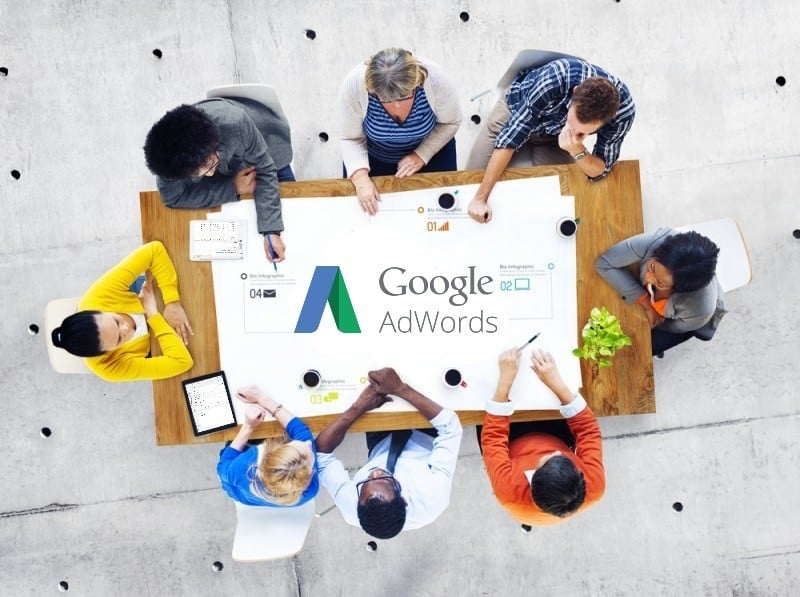Hello!
There’s a great deal of competition to get your business noticed on search engines. Pay per click (PPC) as an advertising technique has been proven to be extremely effective in accomplishing this goal.
 AdWords is the largest PPC platform out there, and the competition is fierce to be ranked as the top advertiser on Google’s powerhouse search engine. Power Traffick states that for every $1.60 a business spends on Google AdWords, they average $3 in revenue.
AdWords is the largest PPC platform out there, and the competition is fierce to be ranked as the top advertiser on Google’s powerhouse search engine. Power Traffick states that for every $1.60 a business spends on Google AdWords, they average $3 in revenue.
Here’s exactly what you need to know to effectively use AdWords management to keep your brand top of mind.
A Refresher on Pay Per Click and Keywords
Proper AdWords management starts with pay per click (PPC). Unlike blanketing a digital site with ads and tracking impressions or views, PPC is tied to a very specific type of engagement metric.
 You’ll need the proper keywords and phrases to match potential customer searches so that your PPC ad pops us when they’re looking for the kind of thing you’re selling.
You’ll need the proper keywords and phrases to match potential customer searches so that your PPC ad pops us when they’re looking for the kind of thing you’re selling.
Google ranks each PPC ad by quality; the better the user experience, the better the quality score.
That’s why it’s so important to have the most relevant keyword, along with a solid landing page, and PPC ad.
The keyword phrase should be mirrored in all three places, which allows a better user experience and increases your quality score.
Winning the Right Keyword
But there is more to the AdWords management process. Once you’ve settled on the proper keywords you have to bid on it to earn your advertising spot on the search engine.
AdWords management happens via an auction where the advertiser bids on the keywords. Google auctions off the keyword and displays the PPC ads on the search engine page in the order of the winning bids.
 Having a high quality score means:
Having a high quality score means:
- A higher ad ranking towards the top of the page.
- A reduced cost per click (CPC).
- You may also win the ad auction with a lower bid.
These are all reasons why your PPC ads should be very targeted with copy that has features, benefits, and a strong CTA that matches your keyword(s) and the customers needs, wants, and priorities.
If you get the keywords wrong, you may end up with a bunch of clicks that aren’t leads but still cost you plenty. That’s why you set limits on your AdWords daily budget.
You can also set up negative keywords that will help hone your search parameters. For example, if you sell only green boots but someone is searching for green tennis shoes, you can exclude “green tennis shows” as part of AdWords management.
AdWords Management Bid Strategy
 AdWords lets you manage bids manually or automate your approach. Some of the strategies include:
AdWords lets you manage bids manually or automate your approach. Some of the strategies include:
- Targeting cost per acquisition (CPA)
- Maximizing clicks
- Focusing on return on ad spin (ROAS)
- Maximizing conversions
- Targeting your location on the search page
- Outranking other ads
- Increasing CPCs
Your ad rotation is up to Google. This goes back to that quality thing – Google picks the best performing ad by your selected metric in the ad group. We recommend selecting “rotate indefinitely,” which will allow you to capture a lot of data on how the ads perform.
Your bid should always include a strategy to reduce bids on keywords that aren’t working well while increasing spend on those that do.
 There are three steps to analyzing this data:
There are three steps to analyzing this data:
- Download your keyword report from the AdWords dashboard. Sort keywords by cost, which will clarify how much you’re spending on the ones that aren’t converting.
- Filter by cost versus conversion.
- Increase your bid on the top performers, if they need it, and if you have the budget.
Also look at audience insight to see the target customers who are in your CTR. Look particularly at location and week/time of day metrics. Age, gender, and household income can all play a factor in your KPIs.
AdWords Management via Campaigns
An AdWords campaign usually includes two or more ad groups. Each should target keywords that users will type into the search engine. For example, a retail store could target keywords for specific products.
 While the overall campaign is for the store itself, each featured produce could have its own Adwords PPC advertisement and budget.
While the overall campaign is for the store itself, each featured produce could have its own Adwords PPC advertisement and budget.
You are automatically opted in to the Google Search Partner Network, which allows your AdWords campaign to roll out across other Google websites, like maps or Google Videos. To opt out, you must uncheck the “include search partners” box before your campaign runs.
Under each campaign lies an ad grouping targeting specific consumers. You can target by geography, or specific themes. This is why it’s so important to understand your target audience before you take on AdWords management. Ad groups within a campaign are very important because they can help raise your quality score.
If you write each ad with the end user in mind, you’ll have a better conversion rate and quality score.
AdWords Management – Dashboards
You can conduct AdWords management via the search query-reporting feature on the dashboard. Go to the keyword tab to view what keywords were being searched for when your ad came up.
 Consider A/B testing on every PPC AdWords campaign. A/B testing lets you gauge the impact of the ad and adjust it based upon your goals. Is the CTA effective? Is the form too long? Have you forgotten keywords in your ad or on your landing page?
Consider A/B testing on every PPC AdWords campaign. A/B testing lets you gauge the impact of the ad and adjust it based upon your goals. Is the CTA effective? Is the form too long? Have you forgotten keywords in your ad or on your landing page?
This is part of the AdWords management process that measures the click through rate (CTR).
Go granular when A/B testing. The greater the differences in the pages, the harder it will be to pinpoint the exact thing that caused your conversions to go up or down.
Google lets you select bid adjustments for desktop, mobile, or tablet. You can run as many ads in an ad group as your budget will allow. We recommend sticking to two or three ads in each group so you can more easily track, gauge, and compare the subtle variations.
A/B testing should happen throughout this process; at some point you may want to pull poorly performing ads and replace them with techniques that you used in the ads that had a better click through rate (CTR).
You can set these ads to run for a specific period of time, alternating them to keep your ideas fresh. Let the dashboard data guide these decisions.
 Here are some of the metrics you should be watching:
Here are some of the metrics you should be watching:
- Clicks
Your CTR is measured by clicks divided by impressions. CTR gives you important insight into whether your copy is compelling enough for people to actually take the effort to dig further. If you have a high impression rate, it means that people are looking for the type of thing you’re selling. But if you have a low CTR it’s time to revisit your keywords and ads because they might be missing the mark.
- Conversions
A conversion is when some completes your CTA. You can place a conversion code on the landing page that tallies these conversions into AdWords. This is an important part of AdWords management, because you’ll easily be able to figure out your cost versus conversion ratio with this data.
- Impressions
Impressions equal how many time your ad is shown on the page. Being able to view each of these metrics separately on the Google AdWords dashboard is particularly important. Successful AdWords management is about measuring and adjusting each piece of this complicated process.
- Revenue
The bottom line goal with revenue is spend versus return on investment. We know that maximizing AdWords management is effective – the statistics have proven that AdWords as a form of SEM can pay you back three-fold. If you’re not getting this kind of return, it’s time to start at the beginning, with your customer needs, and work forward through the steps again.
The dashboard also allows you to automate your reports across all the campaigns you’re running. It’s an easy way to improve your workflows.
Lead Generation or Ecommerce?
There are two primary ways to use PPC, ecommerce or for lead generation. The metrics for measuring how you’re using PPC can vary. For example:
 Ecommerce Metrics
Ecommerce Metrics
- Are based on ROIs or ROAS
- Easy to calculate the ROOI
- Affected by inventory
- Fluctuates based on seasonal/holiday
- Account structure based on pre-purchase behavior
- Relies on repeat buyers
- May use mobile or orders placed via a call center
Lead Generation Metrics
- Cost-per-lead may reflect a contract or other back end process
- Data lags are harder to spot
- Also affected by seasonal fluctuations
- Structure varies based on programs or services offered
- Conversions are usually excluded from paid search because they have already completed your CTA
AdWords management should acknowledge and calculate the data based on seasonal effects or in other ways to accommodate these variances.
AdWords Management – Remarketing
Remarketing is the concept of establishing contact with customers who have already engaged with your website. Your approach should be different because the user already has a send of who you are and what you’re selling.
 Remarketing to these users usually yields a lower CPC but a higher conversion rate. Basically, these individuals are further along in their buying cycle, so remarketing is an attempt to push them to the end of the process.
Remarketing to these users usually yields a lower CPC but a higher conversion rate. Basically, these individuals are further along in their buying cycle, so remarketing is an attempt to push them to the end of the process.
To do this, you must add a Google remarketing code on all pages of your website that will cookie any person that revisits these pages. This tag can last as long as you want it to.
If you go to the Shared Library on your AdWords dashboard under the Audiences tab, you’ll find clear steps for placing the code.
Next, you should create your remarketing lists in an “All Visitors” list, which acts to tag any users that come to your site.
You’ll have to decide if you want to exclude the ones that already have converted; for example, if you’re doing lead generation and the visitor has already filled out the landing form, you’ll want to exclude them from remarketing. You can do this on the Shared Library/Audiences tab.
 There are several types of remarketing campaigns including:
There are several types of remarketing campaigns including:
- Dynamic remarketing for ecommerce campaigns that let’s users see their previous purchases.
- Remarketing lists for search ads (RLSA) lets you remarket ads through Google search. It’s the same kind of AdWords management process, with keywords, etc.
- Remarketing dynamic search ad campaigns (RDSA) creates text ads based on the user’s search and lets Google pick the headline and final URL. This is a smart option that allows you to flex with the changing customer.
- Customer match is available on Youtube, Gmail, and Google. It lets you upload a file of emails that the platforms match with specific customer data that they’ve collected.
- Mobile app remarketing lets you show ads to users who have downloaded your app. The benefits are obvious.
These are just a few of the options currently available with remarketing as an advertising technique. When you’re selling, an important part of the process is making sure you’re capturing both the low hanging fruit, and the customers that have a longer buying cycle. Remarketing lets you gain improved visibility with those that are slower to make a decision.
Also read:
- Chat4Data Launched: The Ultimate Parser That Collects Any Website Data in Seconds
- 7 Unusual Ways to Bring Traffic to Your Website for Free
- Best Practices For Google Adwords Ad Copy and Landing Page Copy
The Final Word on AdWords Management
 AdWords management is a complicated but effective part of SEM. PPC increases brand exposure, sells more products, and builds your customer base. If you do it right, the ROI is outstanding.
AdWords management is a complicated but effective part of SEM. PPC increases brand exposure, sells more products, and builds your customer base. If you do it right, the ROI is outstanding.
It should be noted that, like most advertising techniques, this should not be “one and done.” AdWords management is a living process that evolves as the consumer and market trends affect it.
So, our bottom line is, if you’re already trying for organic rankings, why not add PPC and AdWords management to your advertising campaigns?
Thank you!
Join us on social media!
See you!






